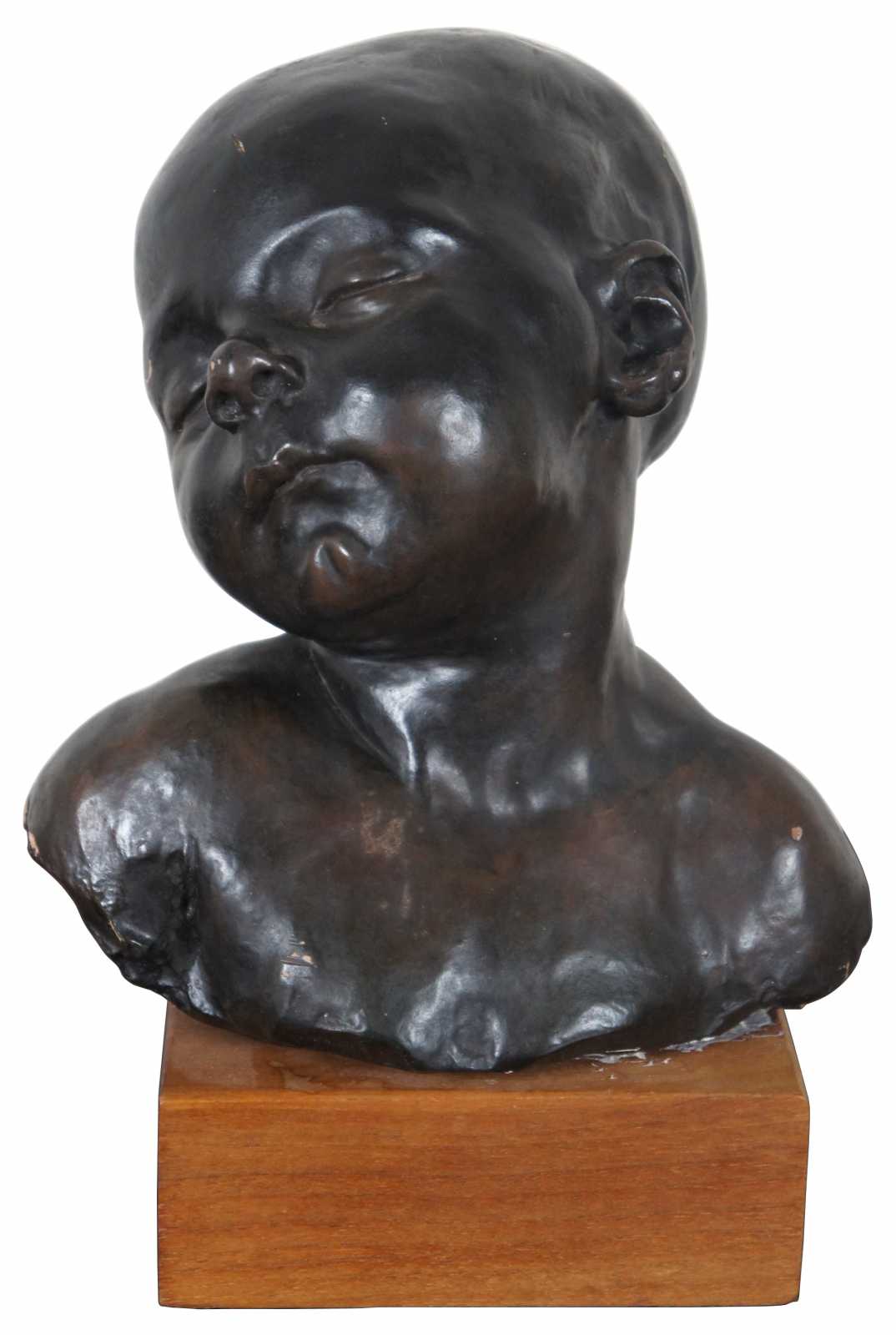
Shipping:
Free Shipping Included
Delivery:
Estimated 2-15 Business Days
Payments:
Credit Card, Check, Cash, PayPal, Apple Pay, Venmo
Returns:
30 Days 100% Money Back Guarantee, Buyer Pays Return Shipping
Description
Vintage Alvastone reproduction desktop or bookshelf sculpture by Alva Museum Replicas of the Head of a Sleeping Baby sculpture by Jules Dalou. “Aime-Jules Dalou (1838-1902) was a French sculptor, recognized as one of the most brilliant virtuosos of nineteenth-century France, admired for his perceptiveness, execution, and unpretentious realism.
Dalou was born in Paris, into from a working-class family of Huguenot background, who raised him in an atmosphere of secularity and Republican socialism. He was the pupil of Jean-Baptiste Carpeaux, who sponsored him for the Petite École (future École nationale supérieure des arts décoratifs), where he sympathysed with Alphonse Legros and Fantin-Latour. In 1854 he attended the École des Beaux-Arts* de Paris in the François-Joseph Duret classroom. He combined the vivacity and richness of Carpeaux, for ""he was, technically, one of the most distinguished modellers of his time"", with the academic insistence on harmonious outlines and scholarly familiarity with the work of Giambologna and others of Duret.
Dalou first exhibited at the Paris Salon* in 1861, but he made no secret of his working-class sympathies. His politics obstructed his career under the Second Empire: he was repeatedly refused the Prix de Rome* that opened sculptors' careers to future official commissions. He started to work for decorators, and there met Rodin with which began there friendship. He made a quiet living providing decorative sculpture for the structures that lined Paris's new boulevards and providing wax models for jewelry. He married Irma Vuillier, a partnership that sustained him throughout his life; they had one daughter, Georgette, who was mentally handicapped and required constant care. Dalou's Daphnis and Chloe shown at the Paris salon of 1869, was purchased by the State.
Having identified himself too publicly with the Paris Commune of 1871, as curator at the Musée du Louvre under Gustave Courbet, he took refuge in England in July 1871, staying at first with his friend Alphonse Legros. He rapidly made a name through his appointment teaching at the South Kensington School of Art*. He was convicted in absentia by the French government of participation in the Commune, and given a life sentence.
In his eight-year English exile, Dalou's association with the National Art Training School and the artists of the New Sculpture movement laid the foundation for new developments in the post-classical British school of sculpture. He also recommended his friend and colleague Edouard Lanteri to move from France to England. At the same time Dalou executed a remarkable series of terra-cotta* statuettes and groups, such as A French Peasant Woman, The Reader, or a serial of Boulogne women like A Woman of Boulogne telling her Beads and a series of informal terracotta portrait busts of friends and acquaintances, rarely signed. He was commissioned to produce the large public fountain called Charity, erected at the back of the Royal Exchange (1878), and for Queen Victoria a monument to two young granddaughters in her private chapel at Windsor (1878).
He returned to France in 1879, after the declaration of amnesty, and produced a number of masterpieces. His great relief of Mirabeau replying to Dreux-Brézé illustrating an encounter of 23 June 1789, which was exhibited in 1883 and later at the Palais Bourbon, and the highly decorative panel Fraternity were followed in 1885 by The Triumph of Silenus. For the city of Paris he executed his most elaborate and splendid achievement, the vast monument, The Triumph of the Republic (detail, left), erected, after twenty years work, in the Place de la Nation, showing a symbolical figure of the Republic, aloft on her car, drawn by lions led by Liberty, attended by Labour and Justice, and followed by Abundance. It is somewhat in the taste of the Louis XIV period, ornate, but with a forward thrust to the ensemble and exquisite in every detail.
Within a few days there was also inaugurated his great Monument to Alphand (1899), which almost equaled in the success achieved the Monument to Delacroix in the Luxembourg Gardens.
His last posthumous works were a statue of Lazare Hoche in Quiberon (1902), the Monument to Gambetta in Bordeaux (1904), the Monument to Émile Levassor (1907) and the Monument to Scheurer-Kestner (1908) in Paris.
Dalou, who was awarded the Grand Prix of the Exposition Universelle (1889), was made a commander of the Legion of Honor. He was one of the founders of the Société Nationale des Beaux-Arts*, and was the first president of the sculpture section.
Dalou is interred in the Cimetière du Montparnasse in Paris.”
Condition
Good Overall - Some chips/scrapes; not securely attached to base/previously re-epoxied; see pictures
Dimensions
7” x 6” x 9” (Width x Depth x Height)